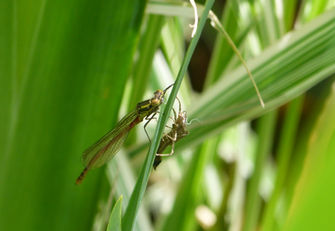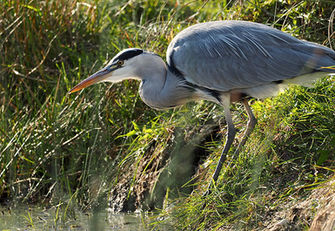Mrs D, Year 3 Teacher
"Fantastic, hands-on day that had great connections to our in- class learning. Thank you for a wonderful experience"
Mr B, Year 6 Teacher
"Fabulously organised and extremely relevant to the curriculum"
Ms P Year 4 Teacher
"The children have had a super, active and engaging day in a great learning environment"

SCHOOL VISITS
Environmental Education Program
Railway Land Wildlife Trust
The Railway Land Wildlife Trust runs a thriving program of engaging, hands on learning, creatively linking to objectives right across the primary and secondary curriculum, from science and geography, to maths, literacy, history and beyond.
The Site:
With woodlands full of birdsong, water meadows brimming with invertebrates, and ponds with frogs, newts and dragonflies, there are so many opportunities to learn here! The Railway Land Nature Reserve is a wonderful mosaic of habitats, bordered by the beautiful River Ouse, which provides a brilliant learning resource with its ever changing tides and flows. A chalk stream, a globally rare habitat, flows through the reserve, and our reed bed welcomes migrant birds such as reed warblers who have travelled over 5,000 miles to nest here.
Learning Sessions:
Learning sessions fully link with the national curriculum and are designed to encourage active, hand-on learning and foster pupils’ connection with the natural world. You will have use of our award winning environmental education centre as your base for the day. Please ask if you’d like us to include your specific learning objectives. Scroll down to see details of the sessions we offer..
Contact our Head of Learning for further information

Outdoor and Environmental Learning Sessions at the
Railway Land Nature Reserve
Rivers 1
The River Ouse flows right through the reserve! Investigate the physical features of the river and its changes over time. Make predictions, collect data to measure its flow, and see how the river fits into the wider landscape. (KS2, KS3)
Rivers 2
Making your rivers study a whole day, and following on from Rivers 1, we look at the human interactions with the river. There is also an option to either complete an annotated field sketch of the river, or observe invertebrates in a freshwater habitat connected to the river system. (KS2, KS3)
Living Things and their Habitats – Freshwater, Woodland or Flower Meadow (seasonal).
Distinguish between living and non-living parts of a habitat, and collect data as required. Observe and Identify invertebrates and other animals in a habitat using simple keys. Focus on specific areas of the science curriculum such as food chains, adaptations, life stages, and classification, according to key stage. Collect data on biodiversity and what this means for our habitats. Play an active game linking to this habitat. (KS1, KS2, KS3)
Fantastic Flora and Perfect Plants
Explore our woodland or meadow habitats (seasonal). Recognise and name the different parts of plants and their functions. Observe and identify a range of common plants including trees, and look at simple ways to classify them. Play an active game to understand what plants need for their survival, and take part in a plant themed craft to help remember plant ID (KS1, KS2).
Evolution Solution
Group activity to show how evolution plays out in a population. Play active game to explore dynamic co-evolution between a species and its habitat. Explore how living things have evolved to be best suited to their environment. Suggest how future changes may impact species and discuss what evolutionary traits they may need to do well in this habitat. (KS2,KS3).
Water and Wildlife
Use our hands-on model to see how water moves this landscape, and how this fits with the wider water cycle. Use our hands-on model of water in our landscape. Identify life in our ponds, ditches and stream, and find out how these habitats change over time. Measure biodiversity in a habitat, or compare biodiversity between watery habitats (KS2, KS3)).
Rocks Rock!
Hold something that lived 100 million years ago! Discover how fossils are made. Study our geology wall made of a variety of rocks spanning millennia. Discuss their formation, compare properties of different rocks, and take part in an activity to show the immense timescale rocks work on. Walk to observe layers of rock in the chalk cliff, with the option to make an annotated field sketch (KS2, KS3)
Superb Soil
A deep dive into the wonderful world of soil! Discuss how vital soil really is, and take part in an activity to show what makes soil. Become soil scientists, take a soil sample, produce soil diagram, and conduct simple tests on it. Observe, ID and collect data on soil invertebrates found, using microscope if conditions allow. Compare soil between 2 different areas if required. (KS2, KS3)
Rocks and Soils (condensed)
A surface deep visit into the world of Rocks and Soils taking elements of each separate session above for a brief look at each subject. Usually includes fossils, geology wall, rock types, soil sample, and soil tests.
Stone Age – Sustainable Ancestors
Engaging pre-history session with a sustainability slant. Explore this landscape as our ancestors did. Can you meet all your survival needs from this land? Fun group challenges around hunting, gathering and crafting. Discuss how we can be sustainable by looking to the past. Option to include fire making on request depending on numbers. (KS2)
Whether the Weather…
Become weather scientists! Weather or climate? Make predictions, then explore our habitats, collecting data from two habitats using a range of scientific equipment. Discuss some fun ways data could be presented, and use it to answer relevant questions about how habitats are influenced by climate. How can we help habitats adapt to changes in climate?
Hunting Stories
Landscape Literacy! Stories lurk in the woods, ponds, and meadows just waiting to be found by those curious enough to search! … Creative literacy and story making series of activities, using our wonderful diverse habitats as inspiration.
Sustainability
A light hearted look at serious sustainable issues. Solution focused games and activities to explore sustainability, including reducing our waste, and what actions we can take to help.
Maths Adventure – Yes, we can make maths active, purposeful and fun! Explore the reserve, measure, count, estimate, sequence and calculate and collect data. Activities will align with curriculum requirements specific for that year group or key stage.
Re-wild Ourselves!
Engaging games and activities exploring the dynamic relationships between predator, prey and their environment, focusing on the positive effects of reintroduction of some key species on biodiversity. Have fun whilst learning about this solution to improve habitats for nature, and bring nature back to balance.
We can also offer forest school, green woodwork and Bushcraft activities. Just ask!
Most day visits have two learning sessions. We will also give you a short pre-visit activity, and where possible, suggestions for follow up activities to link back to classroom activities.
Where is the Railway Land Wildlife Trust?
Situated in the Ouse Valley, the river borders the Railway Land Local Nature Reserve, providing an excellent teaching resource. The whole site is a positive example of regeneration and changing land use, having previously been extensive railway sidings.
We are a fully accessible site. We are near to transport links, and encourage schools to consider travelling to us by sustainable transport where possible.












